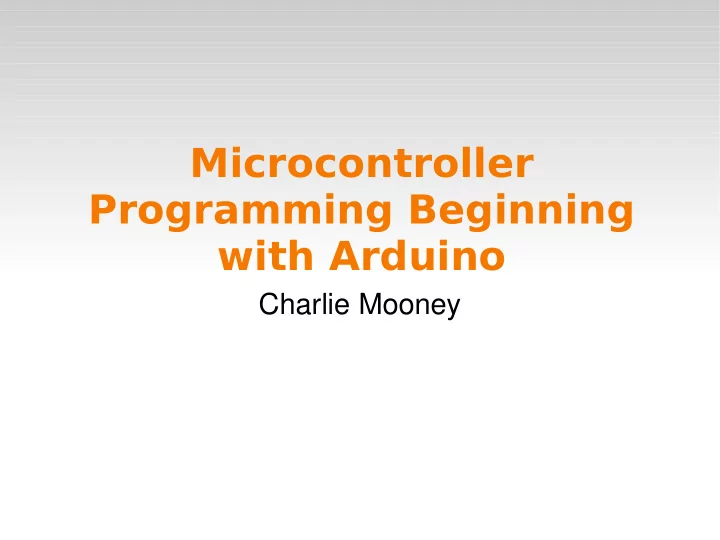

Microcontroller Programming Beginning with Arduino Charlie Mooney
Microcontrollers Tiny, self-contained computers in an IC Often contain peripherals Different packages availible Vast array of size and power availible
Sensory Input Robots need to be able to recieve input from the world in the form of sensory input. Microcontrollers handle this input. Thousands of sophisticated sensors availiable
Pressure/Force Sensors
GPS Locators
Gyroscopes
Wheel Encoders
Infared Proximity Detectors
Accelerometers
Ultrasonic Rangefinders
Alcohol Vapor Density Detectors
Arduino Development board for the ATMega328 Inludes Programmer, Voltage Regulators Seral to USB Converter CHEAP -- $30! Has everything you need!
Arduino C Template void setup() { // Setup stuff to only run once at the beginning } void loop() { // This function gets called indefinatly }
Peripherals Analog to Digital Converters (ADC) Counters/Timers (TMRx) PWM Modules (CCP/PWM) Serial Ports (UART) Many, many more....
Digital I/O Only HIGH and LOW values Each pin configurable to do input or output pinMode(pinNumber, pinState) pinMode(13, INPUT) pinMode(13, OUTPUT)
Digital I/O (Part II) Output digitalWrite(pinNumber, HIGH/LOW) Input int val = digitalRead(pinNumber)
Arduino Digital I/O Example int ledPin = 13; void setup() { // Set the digital pin as output: pinMode(ledPin, OUTPUT); } void loop() { // Bring the pin high (1) digitalWrite(ledPin, HIGH); }
Serial Interface (UART) Communicate with other microcontrollers or PC's Asynch. communication Arduino libraries make it extremely easy Serial.begin(baudRate) Serial.println(”String To Send”) int bytesWaiting = Serial.Availible() Char incomingData = Serial.read()
Arduino Serial Example void setup() { Serial.begin(9600); // Setup baud rate } void loop() { Serial.println(”Give me input”); // output data while(Serial.availible() < 1) { // if there's data waiting char input = Serial.read(); // get a byte of data } }
Analog to Digital Converter (ADC) Take analog voltage as input on one of the pins Return digital representation to program Different numbers of bits change precision.
Light Sensors Photoresistors Extremely Simple to Use Resistance changes with light Measure voltage over the sensor with an ADC, and you're done Many more complicated sensors simulate this behavior for simplicity
Arduino ADC Example int sensorPin = 0; void setup() { Serial.begin(9600); // Turn on Serial Connection } void loop() { // read the value from the sensor: sensorValue = analogRead(sensorPin); // Print sensor value to the Serial Serial.println(sensorValue); }
PWM Modules (CCP) Create PWM signals on output pins Measure PWM signals on input pins CCP stands for Capture/Compare What is PWM, anyway?
Pulse Width Modulation (PWM) Transmit analog values using a single digital input/ output pin through careful timing. A PWM signal consists of two values Period: how long before the signal repeats Pulse Width: how long the signal is HIGH before it goes LOW. Duty Cycle: % of time the signal is HIGH, or (Pulse Width / Period)
PWM In Robotics The average voltage (Duty Cycle * Voltage) can be used to control the speed of DC motors. Innaccurate, poor strength, braking, and other problems exist. Servo Motors and Speed Controllers.
Servo Motors DC Motor with gears allow for high torque Embedded microcontroller monitors PWM input and motor position. Vary pulse width to change position of motor
Speed Controllers Embedded microcontroller varies voltage on output lines based on PWM input. Results in constant voltage to motors rather than intermittent. Allow a second, more powerful, power supply to drive large motors. Alter pusle width to change the speed of the motor
Arduino PWM Command AnalogWrite(Pin, DutyCycle) DutyCycle = 0 → → → 0%, 127 50%, 255 100% Pin can be 3, 5, 6, 9, 10, or 11 Frequency of about 490Htz Other periods are possible, but not with AnalogWrite
Arduino PWM Example int Pin = 9; void setup() { pinMode(Pin, OUTPUT); } void loop() { analogWrite(Pin, 127); // Generate 50% duty cycle on ”Pin” }
Useful Resources Robot Parts and Excellent Forums www.TrossenRobotics.com Electrical parts, sensors, and microcontrollers www.Sparkfun.com Arduino Development Platform www.ardiono.cc
Recommend
More recommend